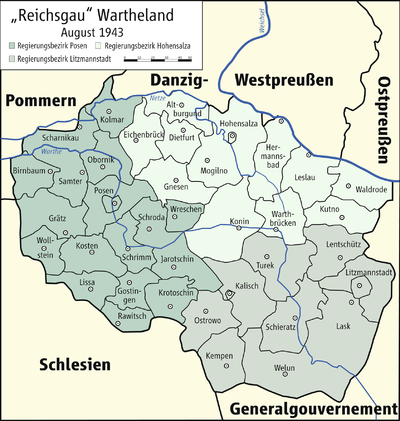Wollstein district

During the Second World War, Wollstein district was the name of a German administrative unit in occupied Poland (1939–45) .
Prehistory (1815 to 1919)
The area around the western Polish city of Wolsztyn ( Wollstein ) belonged to the Bomst district in the Prussian province of Posen from 1815 to 1919 . In the course of the Wielkopolska uprising , Wolsztyn came back under Polish control on January 5, 1919 and was officially ceded to the re-established Poland on June 28, 1919 with the signing of the Versailles Treaty .
Administrative history
At the beginning of the Second World War , German troops occupied the western Polish powiat Wolsztyn , the district town of Wolsztyn was captured on September 5, 1939.
On October 26, 1939, the powiat was annexed to the German Reich under the name of Landkreis Wollstein , which, as a unilateral act of violence, was ineffective under international law. The district became part of the administrative district of Posen in the Reichsgau Wartheland .
The seat of the German district office became the district town of Wollstein .
The German occupation ended with the invasion of the Red Army in January 1945.
politics
Land Commissioner
- 1939 : Schulz
District administrators
- 1939–1944: Rolf Schneider
- 1944–1945: Leyde ( representative )
Municipal structure
The district was divided into a township ( Wollstein ) and 82 rural communities, which were grouped into six administrative districts .
size
The district of Wollstein had an area of 740 km².
population
In 1941, the Wollstein district had: 45,589 inhabitants, mostly Polish.
Between December 1, 1939 and December 31, 1943, the German occupation authorities expelled almost 5,000 Poles from the area.
A German minority lived in the district area (in 1931 about 20% of the total population). During the period of occupation, Germans were also settled. Towards the end of the occupation, most of the Germans left the area.
Place names
During the German occupation in World War II , the German place names valid in 1918 were initially adopted by an unpublished decree of December 29, 1939, but the local occupation authorities soon made “wild” Germanizations. On May 18, 1943, all places with a post or train station were given German names, mostly phonetic adjustments, translations or free inventions.
List of localities in the Wollstein district with more than 700 inhabitants (1910):
| Polish name | German name (1815-1919) | German name (1939-1945) |
|---|---|---|
| Boruja | Old Borui | Mühlengraben |
| Jabłonna | Template |
1939–1943 German fork 1943–1945 Waldgabel |
| Kaszczor | Old monastery | Old monastery |
| Kębłowo | Gable | Gable |
| Kopanica | Kopnitz |
1939–1943 Mittelmühlen 1943–1945 Kopnitz |
| Łąkie | Lonkie | Old meadows |
| Mochy | Mauche |
1939–1943 Deutschendorf 1943–1945 Mauche |
| Nowa Boruja | New Borui | New hop garden |
| Obra | Obra |
1939–1943 Klosterwiese 1943–1945 Obra |
| Przemęt | Priment |
1939–1943 Weißberg 1943–1945 Priment |
| Rakoniewice | Rakwitz | Rakwitz |
| Rostarzewo | Rostarzewo 1886–1898 Rostarschewo 1898–1919 Rothenburg an der Obra |
Rothenburg an der Obra |
| Siedlec | Siedlec |
1939–1943 Kirchdorf 1943–1945 Scheltz |
| Wolsztyn | Wollstein | Wollstein |
Web links
- District of Wollstein administrative history and the district administrators on the website territorial.de (Rolf Jehke), as of August 18, 2013.
- Michael Rademacher: German administrative history from the unification of the empire in 1871 to the reunification in 1990. District of Bomst (until 1919). (Online material for the dissertation, Osnabrück 2006).
- Municipal directory of the district of Bomst 1910